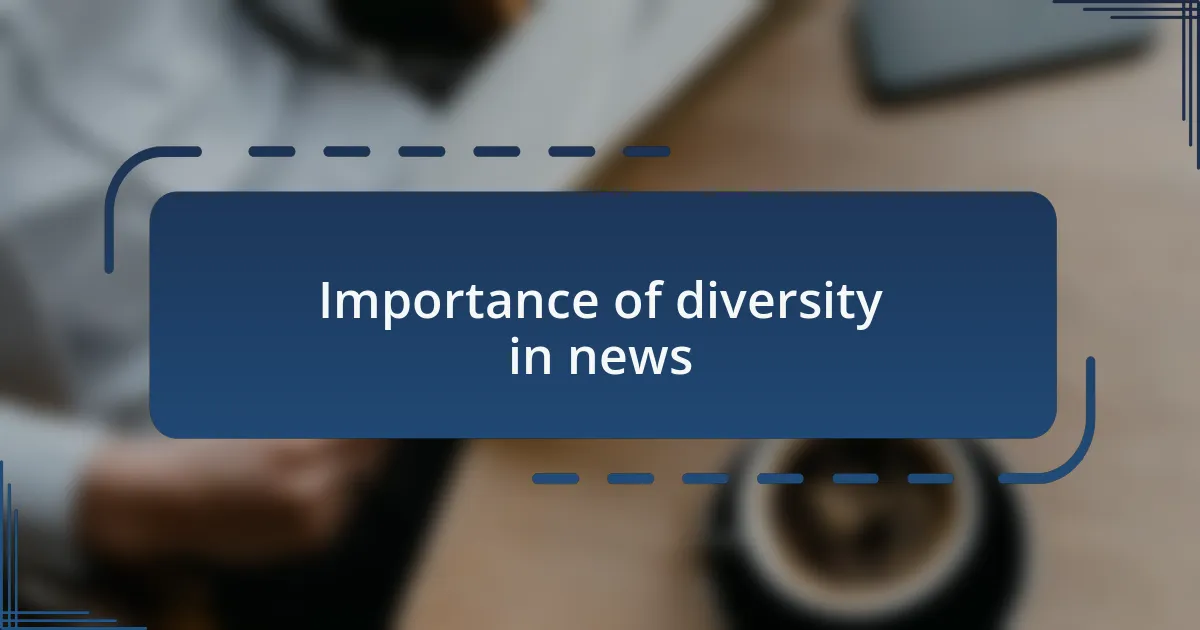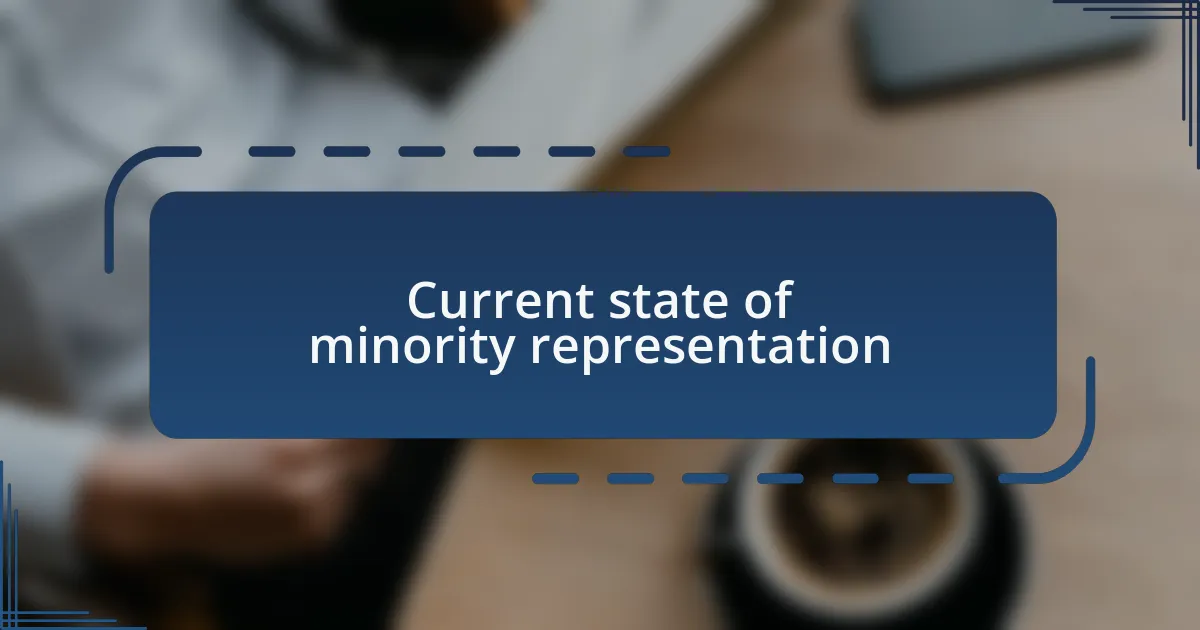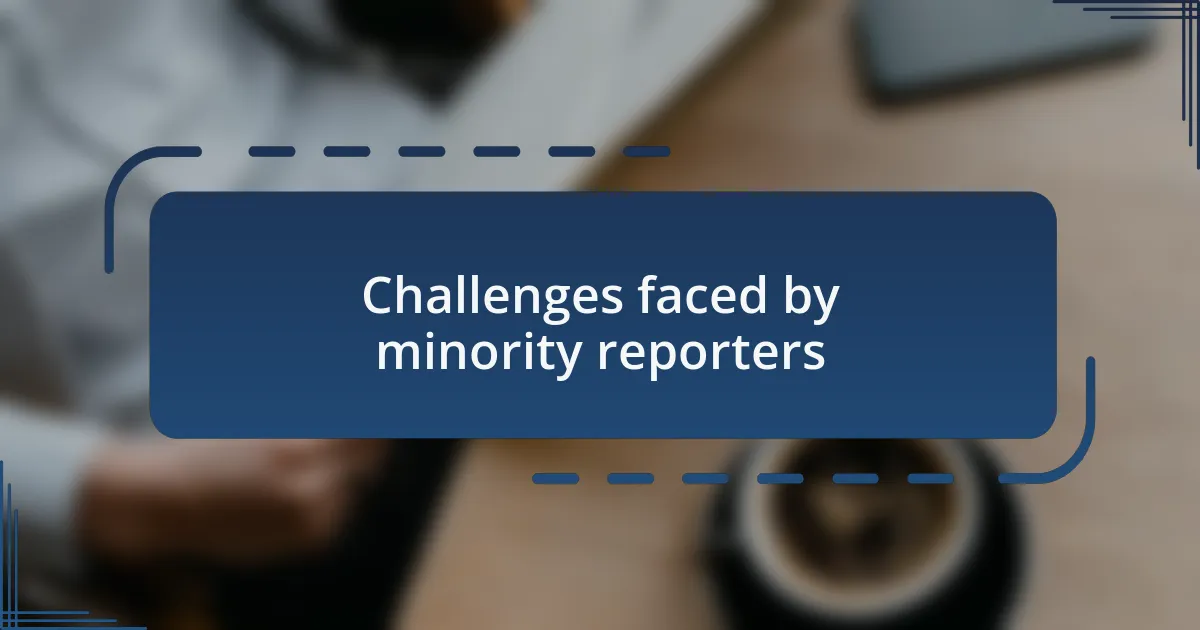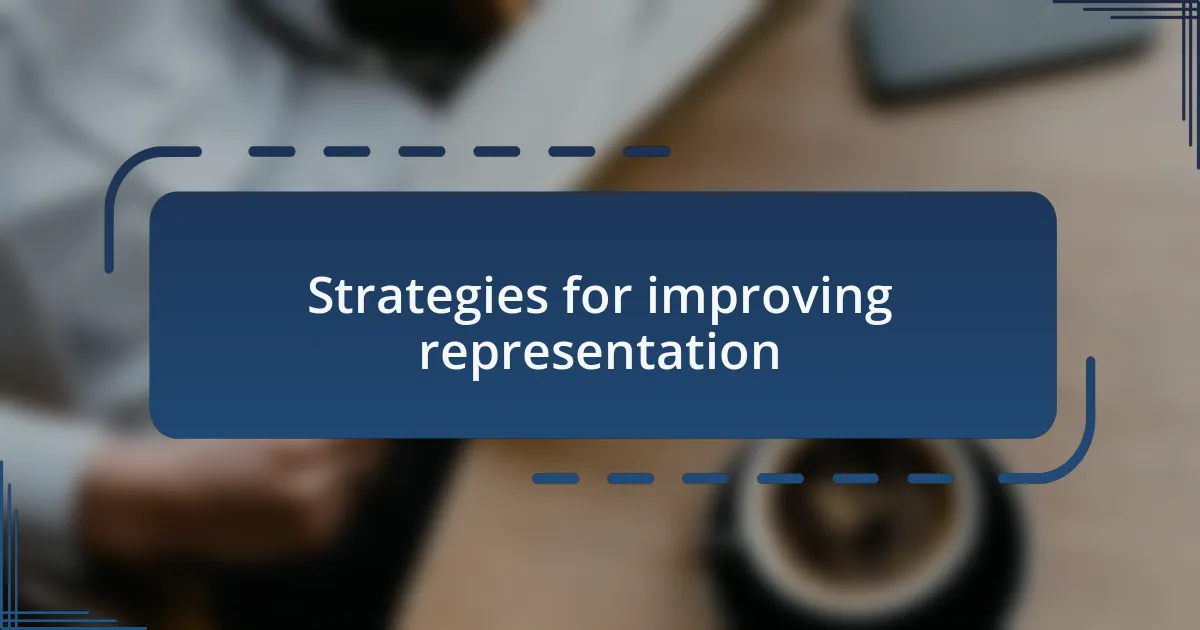Key takeaways:
- Minority representation in media is essential for validation and fostering an inclusive society, as it affects self-image and identity.
- Diversity in newsrooms enriches stories, fosters audience trust, and encourages important public discussions by including varied cultural perspectives.
- Current minority representation in UK news media is lacking, with significant underrepresentation in editorial roles and decision-making positions.
- Supporting minority reporters through mentorship and inclusive editorial practices can significantly improve representation and the quality of storytelling.

Understanding minority representation in media
Understanding how minority representation functions in media is crucial to fostering a truly inclusive society. I’ve often found myself reflecting on how seeing characters that mirror our experiences can validate our own stories. Have you ever watched a film and thought, “That character feels like me”? It’s a powerful realization that can either uplift or isolate viewers, depending on how their identities are portrayed.
I remember watching a documentary about the lives of underrepresented communities. It made me consider the narratives we often overlook. If media shapes perceptions, how can we expect equity when so many voices are silenced? Inclusive representation goes beyond mere visibility; it’s about authenticity and depth in storytelling—ensuring that diverse characters are not just present but are fully fleshed out, with their own unique arcs and complexities.
It’s also important to acknowledge the emotional weight that comes with representation. When marginalized groups are portrayed in limited ways, it perpetuates harmful stereotypes that affect real lives. I’ve seen friends struggle with their self-image because media can sometimes reinforce negative perceptions. Engaging with media that reflects true diversity allows for deeper connections and a richer understanding of our shared human experience. How can we advocate for better representation if we don’t actively seek out those stories?

Importance of diversity in news
Diversity in news is not just a nicety; it’s a necessity for delivering a well-rounded view of our world. When newsrooms include voices from various backgrounds, they tap into a wealth of experiences that enrich reporting. Have you ever considered how a single story can change when told from different cultural perspectives? I once interviewed a community leader whose insights revealed layers of complexity in a local issue that mainstream coverage had missed. That experience showed me that diverse representation not only enhances stories but also fosters understanding among readers.
Moreover, audience trust hinges on seeing oneself reflected in the media. I’ve felt the difference when reading headlines that include viewpoints from people who know the community firsthand, as opposed to generic narratives written by outsiders. It creates a sense of belonging; audiences feel valued and understood. Without this diversity, news may fail to resonate, leaving gaps where critical discussions should occur. Why should we expect accurate representation when the storytellers lack personal connections to their subjects?
The impact of diverse news coverage can ripple through society, influencing public opinion and policy. I recall a specific instance during a national debate where a journalist from a minority background presented data that challenged preconceived notions about their community. The discussion shifted, sparking dialogue where none had existed before. It highlighted how crucial it is for all voices to partake in the narrative-shaping process. When diversity thrives in journalism, it inspires a healthier democracy, encouraging citizens to engage with stories that truly reflect our multifaceted society.

Current state of minority representation
The current state of minority representation in UK news media reveals a mixed picture. While there has been progress, many newsrooms still struggle to reflect the true diversity of society. I once attended a media panel where journalists candidly shared their experiences; it was eye-opening to hear how often they felt marginalized or sidelined within their own organizations.
Statistics indicate that minority groups remain underrepresented in most editorial roles and decision-making positions. I remember feeling a sense of frustration when a major article featured perspectives from communities that were entirely absent in on-the-ground reporting. It makes me wonder: how can we expect authentic storytelling when the narratives are crafted without the full scope of voices?
Moreover, the representation of minorities often fluctuates based on the news agenda. Some events, like cultural festivals or protests, may receive coverage, but daily life and issues faced by these communities can be overlooked. Reflecting on this inconsistency, I couldn’t help but feel that real minority representation should be woven into everyday news, not treated as an exception. How can we encourage a more sustainable commitment to diversity in journalism? Ultimately, it’s about creating a culture that values all voices continuously, rather than only when they fit a certain narrative.

Challenges faced by minority reporters
Minority reporters often encounter significant barriers that can hinder their ability to tell stories authentically. I recall a colleague who faced pushback when trying to pitch stories that resonated with underrepresented communities. It was disheartening to observe how often these valuable narratives were dismissed as niche, highlighting a systemic issue within editorial boards that need to embrace diversity.
The pressure to conform to mainstream perspectives can weigh heavily on minority journalists. I remember feeling the sting of criticism when my reporting didn’t align perfectly with the expectations of what a story about a particular community should look like. This constant struggle can lead to self-doubt, impacting both the quality of reporting and the well-being of these reporters who are passionate about their work.
Additionally, the lack of mentorship opportunities can further complicate the path for minority reporters. It’s frustrating to see talented individuals navigating this landscape without guidance or representation at higher levels. When I think about how mentorship can empower the next generation of diverse journalists, I realize that without deliberate effort to support them, we risk losing those unique viewpoints that enrich our media landscape. How can we create a more supportive environment that not only hires but also nurtures minority talent?

Strategies for improving representation
One effective strategy for improving representation in the media is actively seeking out diverse voices and narratives beyond the usual scope. In my experience, I’ve found that when editing stories, it’s crucial to challenge the traditional sources we often rely on. This doesn’t just diversify stories; it can uncover fresh perspectives that resonate with a broader audience. How often do we step outside our comfort zones to explore underreported stories?
Another key approach is establishing mentorship programs specifically for minority journalists. I once volunteered with a local journalism school, guiding aspiring reporters from diverse backgrounds. Witnessing their growth was not only rewarding but eye-opening as well. It underscored the importance of sharing experiences and fostering an environment where these talented individuals can thrive. Why aren’t more organizations stepping up to replicate this model?
Lastly, fostering inclusive editorial practices can lead to a significant shift. By creating diverse editorial boards, we pave the way for a richer dialogue around representation. In one of my past projects, including team members from various backgrounds led to an enriching ecosystem of ideas and allowed for stories that truly reflected the communities we served. Is it so challenging to recognize that our newsroom culture can be a powerful agent for change?

My personal experiences in media
In my journey through the media landscape, I’ve often been struck by how stories can change when you bring different voices to the forefront. I recall a particularly memorable project where I collaborated with a community group representing a marginalized neighborhood. As we crafted the narrative together, I felt a palpable shift in the energy of the piece. It transformed from a standard news report into a powerful story reflecting the genuine concerns and aspirations of a community often overlooked. Isn’t it fascinating how inclusivity not only enriches content but also fosters authenticity?
During my early days in journalism, I faced the challenge of breaking into spaces that felt exclusive. I remember attending a conference where the speakers were predominantly from similar backgrounds. It hit me then how essential it is to challenge this norm. Sharing my narrative and connecting with other underrepresented journalists became my mission. Those conversations energized me and highlighted the urgency to create spaces where diverse experiences are celebrated. Don’t you think we could all benefit from amplifying voices that have been silenced for far too long?
Finding my footing in media has taught me the value of resilience in advocating for representation. There was a time when a project I led faced criticism for lacking diversity, prompting me to reevaluate our approach. It was a tough lesson, but it pushed me to actively seek out and include sources that genuinely reflected the demographic we were covering. This experience reinforced my belief that representation is not just a checkbox; it’s about telling complete stories that connect us all. How can we ever hope to understand each other without these varied viewpoints?